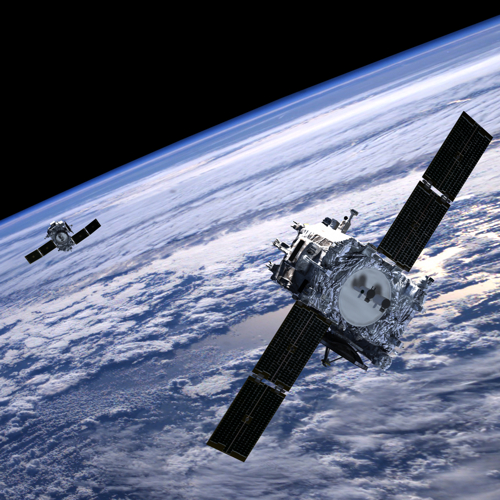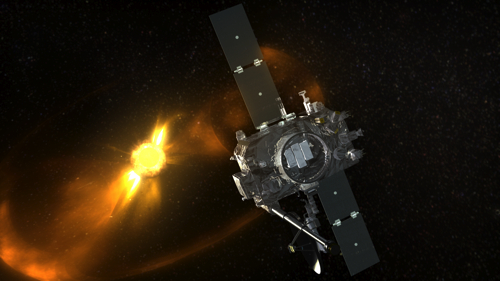GeoTalk is a regular feature highlighting early career researchers and their work. Following the EGU General Assembly, we spoke to Alexis Rouillard, an Arne Richter Outstanding Young Scientist awardee and a brilliant space scientist.
First, could you introduce yourself and let us know a bit about your current work at the French National Centre for Scientific Research?
Hi, I am Alexis Rouillard and I currently work as a permanent researcher at the CNRS, where I investigate heliospheric physics. My research focuses on the physics underlying several phenomena occurring in the vicinity of the Sun, the interplanetary medium and the near-Earth environment. I graduated in 2002 with a Master’s degree in Physics with Mathematics from the University of Southampton and obtained a PhD in Physics and Astronomy in 2007 from the same school. After a three-year postdoc at the Rutherford Appleton Laboratory in the UK and at the University of Southampton, I took the position of Research Associate Professor at George Mason University, Virginia, USA, working at both the Naval Research Laboratory and NASA Goddard Space Flight Center. A little over a year ago, I joined the Institut de Recherche en Astrophysique et Planétologie (CNRS) in Toulouse. This training has exposed me to a wide range of instrumentation and ways of doing research in space physics. I was very fortunate to work with many researchers with very different approaches to solving science questions.
During the EGU General Assembly, you received an Arne Richter Award for Outstanding Young Scientists for your innovative studies in the planetary and space sciences. Could you summarise the research you have done in this area?
My thesis was focused on the origin and effect of some solar wind structures called corotating interaction regions. They form between the Sun and 1AU when fast solar wind is brought into radial alignment with the slow solar wind due to solar rotation. The fast solar wind catches up with the slow solar wind and creates an area of high density (a compression region) that can develop into shock waves. These structures are a temporary barrier to galactic cosmic rays propagating from the interstellar medium into the inner heliosphere, this was the topic of my PhD thesis.
I had just completed my PhD thesis when the Solar-Terrestrial Relations Observatory (STEREO) was launched by NASA (in 2006) with Heliospheric Imagers (HIs) on-board. These HIs provided the first high-resolution images of the solar wind electrons near 1 AU. The white light collected by the heliospheric imagers is photospheric light that is scattered by solar wind electrons. We could demonstrate for the first time that electrons compressed inside corotating interaction regions are systematically imaged by the STEREO HIs when they approach 1 AU (Rouillard et al. GRL, 2008) as well as a number of other phenomena described below.

The Solar-Terrestrial Relations Observatory (STEREO) – an artist’s impression. Source: NASA/JHU APL.
How do you image the impact of a solar disturbance on a planet and what can images like these tell us about near-Earth solar wind conditions?
Although STEREO was launched during an exceptionally quiet period of solar activity, major solar storms were occasionally launched from the Sun into interplanetary space, transporting large clouds of electrons. Since the STEREO HIs were imaging solar wind conditions near the Earth during the start of the mission, we could image several solar storms impacting our planet for the first time. The Earth is so small in these images that all we see is the storm passing over the location of the Earth, not the local deformation that occurs as the storm interacts with the Earth’s magnetic field. During the first three years of the STEREO mission, the orbital position of the spacecraft was perfect to determine the arrival time of a storm at Earth. This new instrumentation has become so useful that future space missions, particularly those dedicated to predicting near-Earth space weather, will have these imagers on-board.
You’ve had to master a huge array of techniques to complete work on solar energetic particles – what advice would you give other young scientists who need to balance their workload with taking time to learn new skills?
My advice is move out of your comfort zone and DARE! Don’t be afraid to plunge into new datasets. Ask the simplest questions first, I’m always surprised to see how little is generally known in many areas.
During the exercise of research, I often find that many of my initial ideas or guesses, even though constructed on logical sequences of arguments turn out to be wrong after close inspection and a thorough test against a wide range of datasets. Nature is always ready to surprise us! Therefore, I tend to avoid areas of science where theories are too far ahead of observational or experimental capabilities – they tend to be stagnating areas of science.
When you start working with datasets that you are not yet familiar with, approach the most productive and creative scientists in your area of research. They never stopped being children and are usually genuinely interested in giving some advice to young scientists thereby often saving you a lot of time.

The Solar-Terrestrial Relations Observatory (STEREO) – an artist’s impression. Source: NASA.
Finally, what are your plans for the future?
I will carry on my research in heliospheric physics to prepare for the future major space missions: ESA’s Solar Orbiter and NASA’s Solar Probe+. Solar Probe +, ‘a NASA mission to touch the Sun’, will go the closest a probe has ever been to the Sun, right where the solar wind is accelerated (9 solar radii). This is very exciting; we will collect the data that is critical to understanding how the solar wind and energetic particles are accelerated to high energies.
ESA’s Solar Orbiter will return to the very inner heliosphere (0.3AU) and will image the solar surface and the solar corona from outside the ecliptic plane. This will provide critical information to answer a wide range of fundamental questions: where are solar magnetic fields generated? How are these magnetic fields expelled? How is energy deposited in the coronal plasma? We are also pushing for a new space mission located, like the STEREO mission, outside the Sun-Earth line to image transients propagating from the Sun to the Earth. Unlike STEREO the mission will remain at a fixed distance from the Earth and will be used by space-weather centres to accurately predict the onset and perhaps the magnitude of geomagnetic storms.
If you’d like to suggest a scientist for an interview, please contact Sara Mynott.
